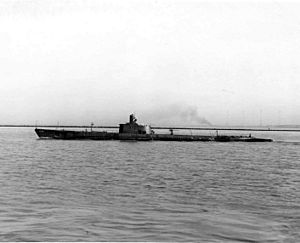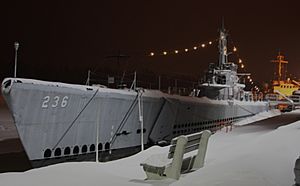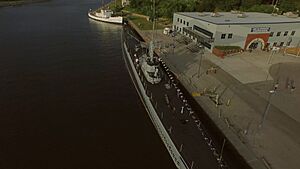USS Silversides (SS-236) facts for kids

USS Silversides (SS-236) on or about 31 March 1942 as she was on sea trials
|
|
| History | |
|---|---|
| Name | Silversides |
| Namesake | silversides |
| Builder | Mare Island Naval Shipyard |
| Laid down | 4 November 1940 |
| Launched | 26 August 1941 |
| Sponsored by | Elizabeth H. Hogan |
| Commissioned | 15 December 1941 |
| Decommissioned | 17 April 1946 |
| Stricken | 30 June 1969 |
| Status | Museum ship at Muskegon, Michigan |
| General characteristics | |
| Class and type | Gato-class diesel-electric submarine |
| Displacement |
|
| Length | 311 ft 9 in (95.02 m) |
| Beam | 27 ft 3 in (8.31 m) |
| Draft | 17 ft (5.2 m) maximum |
| Propulsion |
|
| Speed |
|
| Range | 11,000 nmi (20,000 km; 13,000 mi) surfaced at 10 knots (19 km/h; 12 mph) |
| Endurance |
|
| Test depth | 300 ft (90 m) |
| Complement | 6 officers, 54 enlisted |
| Armament |
|
|
USS Silversides
|
|

Silversides, a national landmark and a museum, at "full dress ship" in Muskegon for the U.S. Navy's Submarine Centennial, 3 June 2000
|
|
| Location | Muskegon, Michigan |
| Built | 1941 |
| NRHP reference No. | 72000453 |
| Significant dates | |
| Added to NRHP | 18 October 1972 |
| Designated NHL | 14 January 1986 |
The USS Silversides (SS/AGSS-236) is a famous Gato-class submarine. It was the first ship in the United States Navy named after the silversides, a type of small fish.
Silversides was one of the most successful submarines during World War II in the Pacific Ocean. It sank 23 enemy ships, which weighed over 90,000 tons in total. This amazing record earned the submarine a special award called the Presidential Unit Citation. It also received twelve battle stars for its brave actions. Today, the Silversides is a museum ship in Muskegon, Michigan, and is recognized as a National Historic Landmark.
Contents
Building a War Hero
The construction of Silversides began on November 4, 1940. It was built at the Mare Island Navy Yard in Vallejo, California. The submarine was officially launched on August 26, 1941. Mrs. Elizabeth H. Hogan was its sponsor, a special role for a ship's launch.
Silversides was then officially put into service on December 15, 1941. Lieutenant Commander Creed C. Burlingame was its first commanding officer.
World War II Adventures
First Missions and a Fishnet Surprise
After practicing off the California coast, Silversides sailed to Hawaii. It arrived at Pearl Harbor on April 4, 1942. On April 30, the submarine began its first war patrol near Japan.
On May 10, Silversides used its deck gun to damage a Japanese guard boat. Sadly, during this fight, one of its crew members, Mike Harbin, was killed. He was the only crew member lost in action on Silversides during the entire war.
A few days later, on May 17, something very unusual happened. While getting ready to attack, the submarine's periscope got tangled in a Japanese fishing net! But Silversides kept going, net and all. It fired torpedoes and sank a 4,000-ton cargo ship. This might be the only time an American submarine attacked while flying a Japanese flag (accidentally!). The submarine finished its first patrol on June 21.
More Victories in the Pacific
Silversides went on its second war patrol from July 15 to September 8. It was still near Japan. On July 28, it sank a 4,000-ton transport ship. Then, on August 8, it sank the passenger and cargo ship Nikkei Maru.
The submarine also damaged a large tanker on August 14. Before returning to Pearl Harbor, it sank two enemy trawlers on August 31.
Its third patrol was in the Caroline Islands. While it didn't sink any ships this time, it heavily damaged a large cargo ship. It also hit a Japanese destroyer or minelayer. Silversides ended this patrol in Brisbane, Australia, on November 25.
An Emergency Operation at Sea
Silversides left Australia on December 17, 1942, for its fourth patrol. This mission took it to New Ireland. On December 22, a crew member, George Platter, needed an emergency appendectomy.
Pharmacist’s Mate First Class Thomas Moore performed the surgery. He used ether for anesthesia and tools made from kitchen utensils! The operation was a success.
Right after the surgery, the submarine surfaced. But it was immediately attacked by a Japanese destroyer and airplane. Silversides was forced to dive deep and suffered damage to its bow planes. It managed to escape and make repairs.
On January 18, 1943, near Truk, Silversides sank its biggest target: the 10,022-ton oil tanker Toei Maru. Two days later, it had one of its best days. It sank three cargo ships: Surabaya Maru, Somedono Maru, and Meiu Maru.
During this patrol, a torpedo got stuck in a tube. It was very dangerous, but the crew managed to refire it safely. The submarine returned to Pearl Harbor on January 31 for major repairs.
Mines, Torpedoes, and Tough Times
Silversides began its fifth patrol on May 17 in the Solomon Islands. Its main job was to lay mines in Steffan Strait. But it also looked for enemy ships.
On June 10–11, it sank the 5,256-ton cargo ship Hide Maru. After this, it had to endure a severe depth charge attack. The submarine returned to Brisbane on July 16.
For its sixth patrol, from July 21 to September 4, Silversides patrolled between the Solomons and Carolines. This time, it faced problems with its torpedoes and found few targets. It returned to Brisbane without sinking any ships.
Hunting Convoys and Saving Ships
On October 5, Silversides started its seventh patrol. It sank four enemy ships from the Solomon Islands to New Guinea. On October 18, it sank the cargo ship Tairin Maru. On October 24, it sank the cargo ships Tennan Maru and Kazan Maru, and the passenger/cargo ship Johore Maru. It returned to Pearl Harbor on November 8.
For its eighth patrol, Silversides was off the Palau Islands. On December 29, 1943, it attacked an enemy convoy. It sank the cargo ships Tenposan Maru, Shichisei Maru, and Ryuto Maru. This patrol ended on January 15, 1944.
The ninth patrol started on February 15, west of the Marianas Islands. On March 16, it sank the cargo ship Kofuku Maru. The submarine then returned to Fremantle on April 8.
On its tenth patrol, again near the Marianas, Silversides destroyed six enemy ships. On May 10, it sank the cargo ship Okinawa Maru, the passenger/cargo ship Mikage Maru, and the gunboat Choan Maru Number Two. Ten days later, it sank another gunboat, the Shosei Maru. On May 29, it sank the cargo ships Shoken Maru and Horaizan Maru. It returned to Pearl Harbor on June 11.
Helping Other Submarines and Final Missions
Silversides began its eleventh patrol on September 24, off Kyūshū, Japan. This patrol was quiet for Silversides, but it helped a sister submarine, Salmon (SS-182). Salmon was badly damaged and needed help escaping enemy ships.
Silversides bravely drew the attention of some enemy escorts. Other submarines, Trigger (SS-237) and Sterlet (SS-392), also joined in. Together, they helped escort the damaged Salmon to Saipan. Silversides finished this patrol on November 23.
The twelfth patrol started on December 22, 1944, in the East China Sea. On January 25, 1945, it torpedoed the 4,556-ton cargo ship Malay Maru. It returned to Midway Island on February 12.
For its thirteenth patrol, Silversides worked with other submarines in a coordinated attack group. They patrolled off Kyūshū. It damaged a large freighter and sank a trawler. This patrol ended on April 29.
Silversides' fourteenth and final war patrol began on May 30. It served as a "lifeguard" submarine, ready to rescue pilots whose planes were shot down. On July 22, it rescued a fighter pilot. Two days later, it saved another airman. This patrol ended on July 30 in Apra Harbor, Guam. The war ended on August 15 while the submarine was there.
Life After War: A Training Ship
After the war, Silversides traveled through the Panama Canal. It arrived in New York City on September 21, 1945. On April 17, 1946, it was taken out of active service.
From October 15, 1947, it became a training ship for Naval Reservists in Chicago, Illinois. It stayed in Chicago as a stationary training vessel for many years.
On June 30, 1969, Silversides' name was removed from the Navy's list of ships. But people wanted to save it. The South Chicago Chamber of Commerce asked the Navy to let them keep Silversides as a memorial.
Becoming a Museum Ship
On May 24, 1973, Silversides became part of the Combined Great Lakes Navy Association in Chicago. Volunteers worked hard to restore the submarine. They spent thousands of hours cleaning, repairing, and painting it.
When volunteers first saw it, the submarine was in rough shape. Paint was peeling, and there was a lot of junk inside. But they worked tirelessly to bring it back to life. They replaced old parts, fixed leaks, and restored the engines.
In 1979, the submarine moved to Navy Pier in Chicago. That July, its first main engine was started for the first time since 1946! In 1987, Silversides moved to Muskegon, Michigan. There, it became the main attraction of the new Great Lakes Naval Memorial & Museum.
Normally, active submarines are dry-docked every five years for maintenance. But for a permanently moored freshwater ship, this can be extended to 25 years. In 2004, after 55 years, a fund was started to help dry-dock and overhaul Silversides.
Silversides on the Big Screen
Silversides was used in the 2002 movie Below. It played the part of a fictional submarine called USS Tiger Shark. The submarine was towed in Lake Michigan for the filming.
Awards and Achievements
Silversides earned twelve battle stars for its service in World War II. It also received a Presidential Unit Citation. This award recognized its amazing actions over four patrols.
It is officially credited with sinking 23 ships. This makes it the third most successful Allied submarine in World War II. The total weight of ships sunk by Silversides was 90,080 tons. This places it among the top five American submarines for tonnage sunk during the war.
Visit the USS Silversides Museum
The museum was first called the Great Lakes Naval Memorial & Museum. Now, it is known as the USS Silversides Submarine Museum. It also features the USCGC McLane (WSC-146), a United States Coast Guard cutter, and a museum building.
The museum staff starts the Silversides' Fairbanks Morse engines up to six times a year. This helps keep the powerful engines in good working condition.
See also





